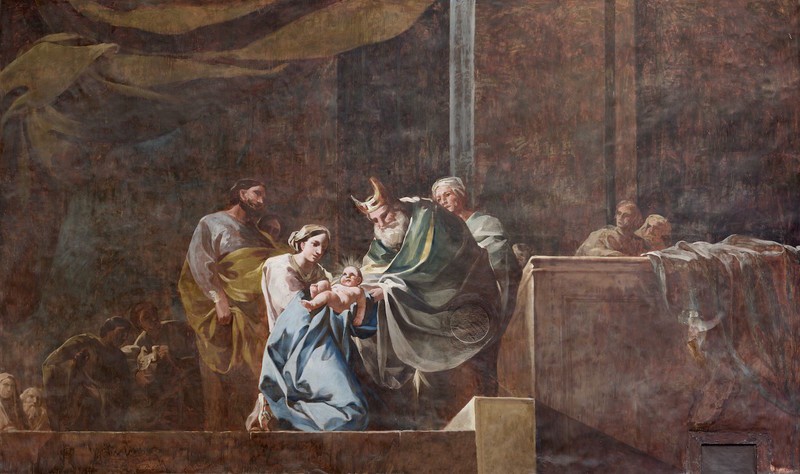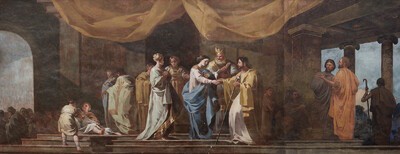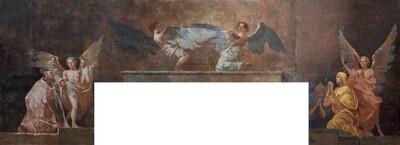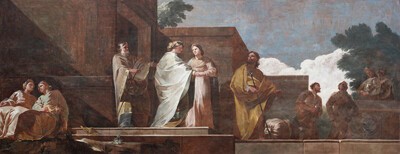- Cronología
- Ca. 1774
- Ubicación
- Church of the Monastery of Aula Dei, Zaragoza, Spain
- Dimensiones
- 306 x 520 cm
- Técnica y soporte
- Oil on plaster
- Reconocimiento de la autoría de Goya
- Documented work
- Titular
- Instituto Chemin Neuf
- Ficha: realización/revisión
- 07 Oct 2010 / 13 Jun 2023
Located on the left-hand side of the presbytery, this work occupies a smaller space than the other paintings. Nevertheless, it repeats the same compositional pattern, with a central group that dominates the scene highlighted with lighter, more vivid coloured clothing and more light, which in this case emanates from the Christ Child pictured naked in the Virgin's arms at the centre of the scene. Mary is on her knees passing her son to the Hebrew priest who extends his arms to take the child. Saint Joseph stands behind the Virgin - as always in the middle ground - wearing a yellow cloak. Behind the priest, half hidden by her robes, there is an old woman with a white headdress who can be identifiable as a prophetess.
The rest of the figures seem to be observing the action of the main group from the shadows in the background, which is framed by great drapes and simple, very linear architectural elements. A great stone font half covered with cloths occupies a sizable part of the space on the right-hand side of the painting.
See Revelation to Saint Joachim and Saint Anne for a history of the complete set of works housed in this church.
Restauradas por Carlos Barboza y Teresa Grasa entre 1978 y 1979.
Restaurada por el Gobierno de Aragón entre 2009 y 2011: se hizo un estudio del estado de conservación, limpieza, consolidación, eliminación de sales, análisis y estudios ambientales, eliminación de elementos nocivos para la película pictórica, saneamiento y restauración de grietas, restauración de marcos y dotación de una iluminación apropiada.
-
Goya, su tiempo, su vida, sus obrasMadridTipografía de Manuel G. Hernández, Impresor de la Real Casa1887p. 462
-
Vie et ouvre de Francisco de GoyaParísOffice du livre1970pp. 39-41 (il.), cat. 42-48
-
BarcelonaPolígrafa1970vol. I, pp. 241-242
-
Las pinturas de Goya en la Cartuja de Nuestra Señora de Aula-DeiZaragozaMutua de Accidentes de Zaragoza1975
-
Sobre los documentos conservados en la cartuja de Aula DeiSeminario de Arte AragonésZaragoza1980pp. 119-122
-
Goya y Aragón. Familia, amistades y encargos artísticoscol. Col. Mariano de Pano y RuataZaragozaCaja de Ahorros de la Inmaculada de Aragón1995pp. 107-118 (il.)
-
Las pinturas murales de Goya en AragónMadridGobierno de Aragón y Electa España1996pp. 39-47
-
Las pinturas murales de Goya en la cartuja de Aula DeiFundación Goya en Aragón y Turner2008vol. II, pp.123-137
-
Goya antes del viaje a Madrid (1746-1774)BarcelonaGalaxia Gutenberg/Círculo de Lectores y Fundación Amigos del Museo del Prado2010pp. 315-336






